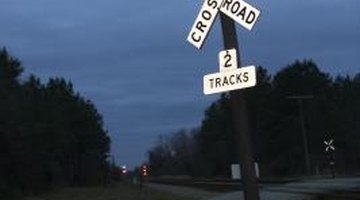How to Build a Crossbuck
A crossbuck has several definitions that all involve an X-shaped pair of boards or logs. Painted railroad crossing signs are known as crossbucks, as are the rustic type of fence, which features a log support spanned by long poles or rails. On a similar note, the fancy, white, horse fences with the crossing X pattern are also known as crossbuck fences. Perhaps most useful to the homeowner or farmer are the simple crossbucks that hold a log several feet off the ground while someone lops off the log end with a chain or hand saw.

-
Cut the 2-by-4s into four-foot lengths. Use the tape measure to mark the length, and use the speed square and pencil to scribe the cut across the face of the 2-by-4. Do all the cutting on the sawhorses while using safety goggles.
-
Select four of the four-foot pieces of 2-by-4 and mark each one at 32 inches with the tape measure. Then extend this mark across the face of the 2-by-4, but do not cut the 2-by-4. These marks are only necessary for aligning the cross pieces.
-
Set one of the marked 2-by-4s on top of another to form a X shape. The pencil marks should line up to form a V. That is to say the bottom point of each mark should visually meet at one point to form a large X with the two pieces of wood.
-
Nail the two pieces of 2-by-4 together with 12-penny galvanized nails. Drive the nails from both the top and bottom side of the pair of 2-by-4s. Do this for both pair of crosses.
-
Set the crosses in an upright position so the short ends are above the long ends. Then make a pencil mark 1 1/2 inches up from the V-shaped notch. Do this on all four upright boards.
-
Nail the remaining pair of four-foot 2-by-4s to the upright members. Use the inch-and-a-half marks as the starting point when setting the four-foot boards in place. These two boards should run horizontally, connecting one X-shaped support to the other.
-
Run the 1-by-4 diagonally from one support leg to the other. Ideally, this brace should be about six inches off the ground. Nail the brace in place with the 6-penny galvanized nails and lop the ends off with the crosscut saw.
Tips
- Paint the crossbucks if they are to remain outside in the weather.
Warnings
- When cutting an eight-foot length of 2-by-4 into two equal pieces, have a helper to hold one end of the board.
Writer Bio
Henri Bauholz is a professional writer covering a variety of topics, including hiking, camping, foreign travel and nature. He has written travel articles for several online publications and his travels have taken him all over the world, from Mexico to Latin America and across the Atlantic to Europe.
Photo Credits
- Thinkstock/Comstock/Getty Images
More Articles



